The AMD Radeon R9 290 Review
by Ryan Smith on November 5, 2013 12:01 AM EST- Posted in
- GPUs
- AMD
- Radeon
- Hawaii
- Radeon 200
Overclocking
Finally, let’s spend a bit of time looking at the overclocking prospects for the 290. Without any voltage adjustment capabilities and with AMD binning chips for clockspeeds and power consumption we’re not necessarily expecting a lot of headroom here, but none the less it’s worth checking out to see how much more we can squeeze out of the card.
Even though we’re officially limited to AMD’s Overdrive utility for the moment for overclocking, Overdrive offers a wide enough range of values that we shouldn’t have any problem maxing out the card. In fact we’ll be limited by the card first.
| Radeon R9 290 Overclocking | |||
| Reference Radeon R9 290 | |||
| Shipping Core Clock | 662MHz | ||
| Shipping Boost Clock | 947MHz | ||
| Shipping Memory Clock | 5GHz | ||
| Shipping Boost Voltage | ~1.18v | ||
| Overclock Core Clock | 790MHz | ||
| Overclock Boost Clock | 1075MHz | ||
| Overclock Memory Clock | 5.6GHz | ||
| Overclock Max Boost Voltage | ~1.18v | ||
Despite the lack of voltage control, when it comes to overclocking the 290 we were able to achieve solid overclocks on both the GPU and the memory. On a boost clock basis we were able to push the 290 from 947MHz to 1075MHz, an increase of 128MHz (14%). Meanwhile we were able to push the memory from 5GHz to 5.6GHz before artifacting set in, representing a 600MHz (12%) memory overclock. Being able to increase both clockspeeds to such a similar degree means that no matter what the video bottleneck is – be it GPU or memory – we should see some kind of performance increase out of overclocking.
On a side note, for overclocking the 290 we stuck with moderate increases to both the maximum fan speed and the PowerTune limit. In the case of the former we used a 65% maximum fan speed (which actually proved to be more than what’s necessary), while for the latter we went with a 20% increase in the PowerTune limit, as at this point in time we don’t have a good idea for what the safe power limits are for the reference 290/290X board. Though in either case only FurMark could push the overclocked card to its power limit, and nothing could push the card to its fan speed limit. Similarly we didn’t encounter any throttling issues with our overclocked settings, with every game (including CoH2) running at 1075MHz sustained.
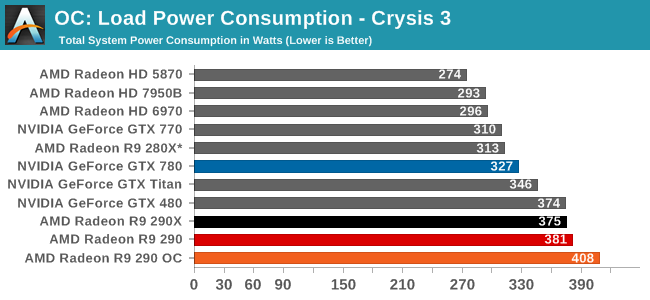
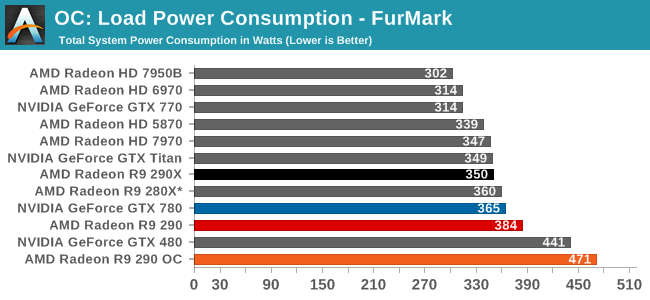
Taking a brief look at power, temp, and noise before jumping into our gaming performance results, we can see that overclocking the card has a measurable impact on power consumption under both Crysis 3 and FurMark. With Crysis 3 we’re clockspeed limited before we’re power limited, leading to an increase in power consumption of 27W, while under FurMark where we were power limited it’s a much more academic increase of 87W.
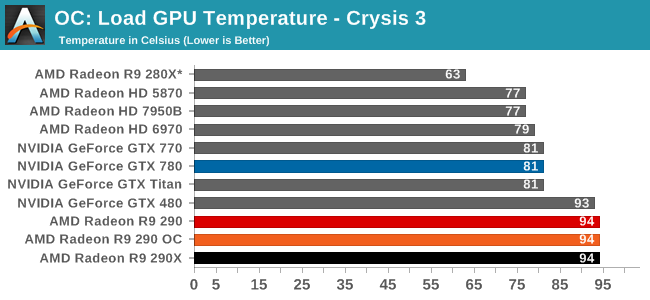
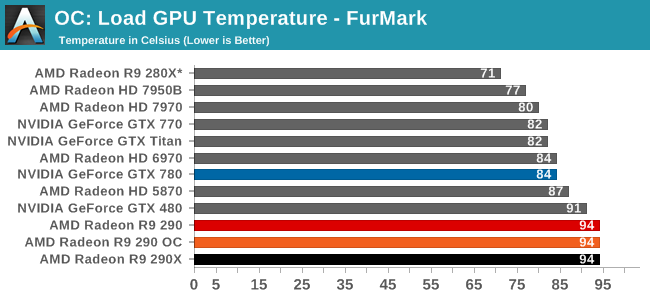
Since the 290 already ships at the highest temperate limit it allows – 95C – our sustained temperatures are unchanged even after overclocking.
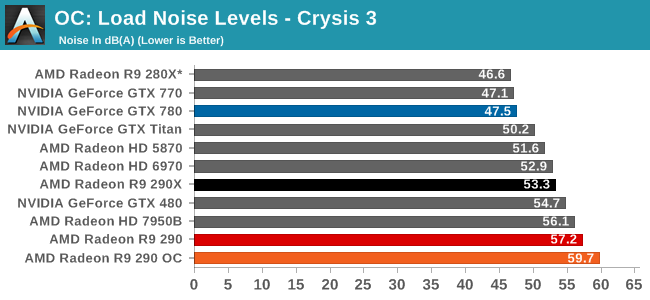
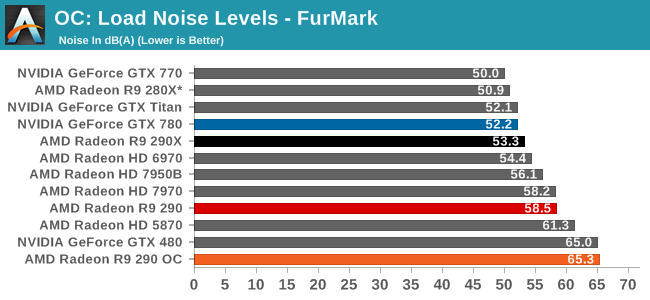
The 290 is already an unreasonably loud card at stock, and unfortunately the fan speed increases needed to handle the greater heat load from overclocking only make this worse. Under Crysis 3 we peaked at 59.7dB, or 49% fan speed. While under FurMark we peaked at 65.3dB, or 59% fan speed. For these noise levels to be bearable the 290 really needs to be fully isolated (e.g. in another room) or put under water, as otherwise 59.7dB sustained is immensely loud for a video card.
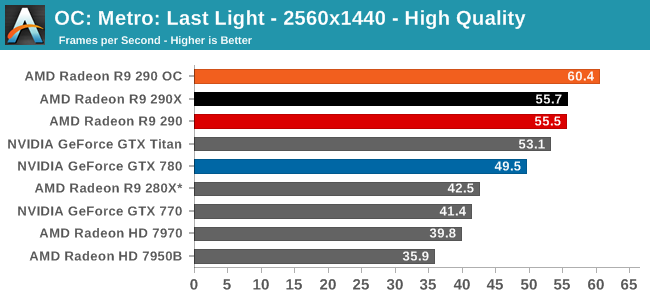
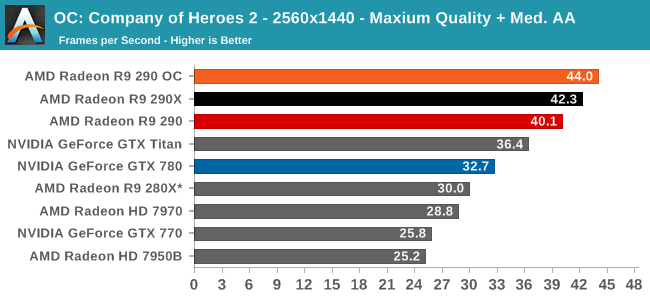
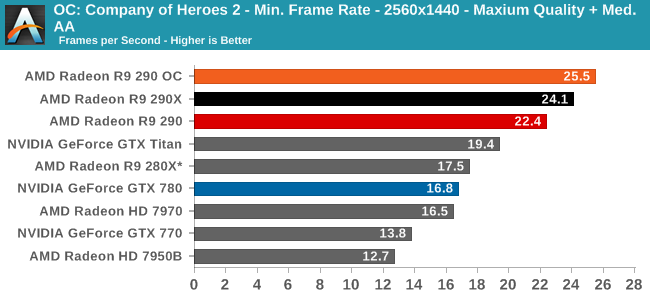
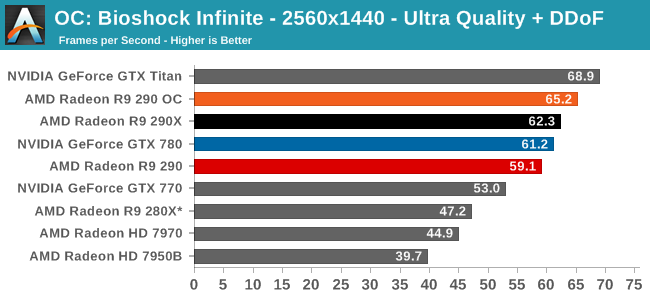
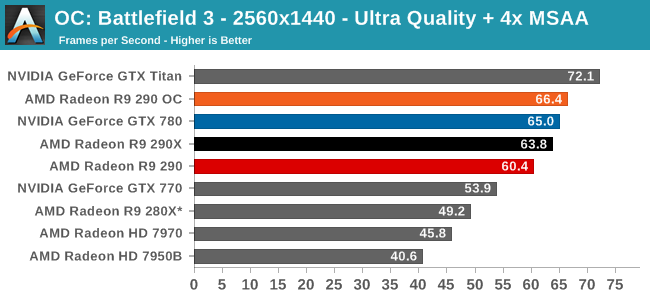
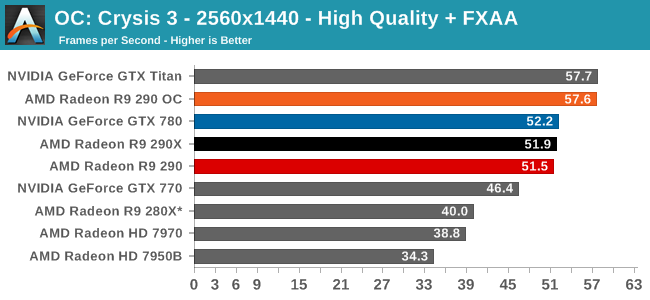
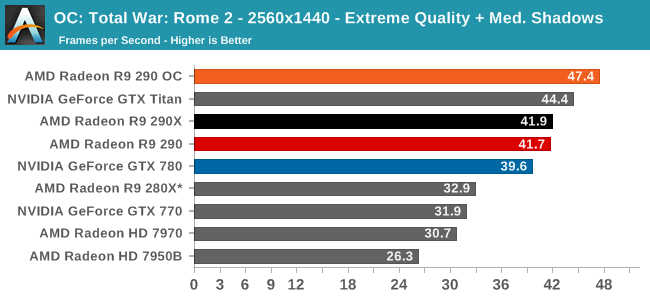
Finally getting to the matter of game performance, we’re seeing consistently strong scaling across every game in our collection. The specific performance increase depends on the game as always, but a 14% core overclock and 12% memory overclock has netted us anywhere between 9% in Metro up to the full 14% in Total War: Rome II. At this performance level the 290 OC exceeds the performance of any other single-GPU card at stock, and comes very close to delivering 60fps in every action game in our benchmark suite.










295 Comments
View All Comments
RussianSensation - Tuesday, November 5, 2013 - link
Spot on. People continue to focus on reference GPU performance but unless you have a cramped case (which you shouldn't really have with such premium components) or are going quad-fire, using a reference cooler is almost always inferior to open-air dual slot designs with heatpipes and larger 80-100mm fans.hoboville - Tuesday, November 5, 2013 - link
Yup, there have been some cards (EVGA 780 w/ ACX cooler) that have benefited tremendously from special dual-slot coolers. That card was highly overclocked, ran cooler than reference, and was 95%+ of Titan performance. It was also only $10 more than the base 780.It just makes no sense that AMD has to flash around their reference cooler for 2 months with a shoddy card before we, as consumers, can buy a decent card that isn't just for looks (cooler shroud, anyone?).
aznjoka - Tuesday, November 5, 2013 - link
This makes Nvidia's price drop, well looked over. The price/performance ratio of the 290, is quite well and back down at practical levels. AMD has done us all a great doing, saving our pockets from being emptied by the hungry Green men.Homeles - Tuesday, November 5, 2013 - link
The same AMD that charged us out of our rears for the newly-launched 7000 series, mind you.Spunjji - Tuesday, November 5, 2013 - link
They're both as guilty as each other on that one.techkitsune - Tuesday, November 5, 2013 - link
" we cannot in good faith recommend a card this loud when any other card is going to be significantly quieter."That's nothing at all. Try throwing that against my 3 9000RPM Delta fans, each at -65dBA. -57dBA? Hah!
I could put four of these 290 GPUs in my tower and my three Deltas would still scream louder.
jljaynes - Tuesday, November 5, 2013 - link
Agreed - I consider myself an old school PC builder. If my rig doesn't sound like a prop plane taking off when I press the power button I am doing something wrong. I come from an era where a nerd's worth is measured by the number of case fans he has on his PC. I thought builders that put fan controls on their rigs were sissies. It's all or nothing - on or off, don't you turn down the speed.That, and any self respecting gamer uses a good set of headphones => noise is pretty much irrelevant, at least IMO.
techkitsune - Tuesday, November 5, 2013 - link
That's right. Hunt with your ears as your FOV is very limited. Headphones are the only way to go in this regard with the super-power of Delta in your case.HisDivineOrder - Tuesday, November 5, 2013 - link
It must be nice thinking everyone is talking low, but your hearing damage causes you not to notice what you're missing. When you're asking everyone to speak up, don't be surprised.jljaynes - Tuesday, November 5, 2013 - link
Go look up "noise isolation" or "noise canceling"